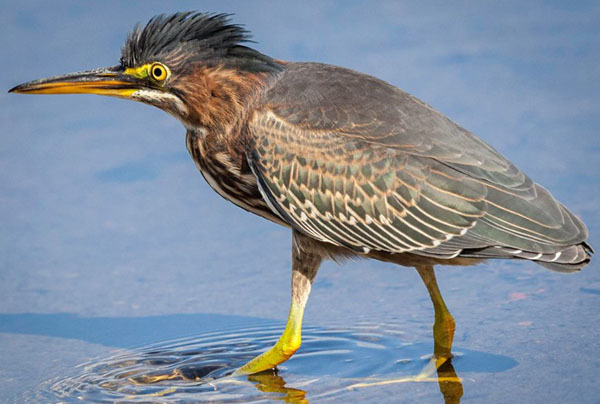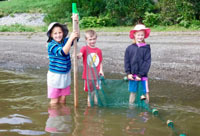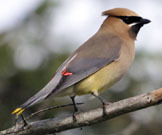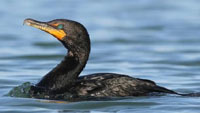Hudson River Almanac 9/15/18 - 9/21/18
The New York State Department of Environmental Conservation sent this bulletin on 09/28/2018 02:00 PM EDT |
| DEC Delivers - Information to keep you connected and informed from the NYS Department of Environmental Conservation |
| Share or view as a web page || Update preferences or unsubscribe |
|
Compiled by Tom Lake, Hudson River Estuary Program Consulting NaturalistOVERVIEWThis week’s increase in the autumn raptor migration featured broad-winged and sharp-shinned hawks. In the river, the seaward drift (they are in no hurry) of young-of-year fishes continued. The river was giving up its submerged aquatic vegetation as evidenced by green ropy tiderows on beaches. HIGHLIGHT OF THE WEEK
Our most exciting catch was an 80-millimeter (mm-pp) female “Sally” blue crab. Female blue crabs are not common upriver from brackish water. The fish were a nice mix of young-of-year blueback herring (49-71 mm), alewives (54-58 mm), and striped bass (66-69 mm), part of the late-summer “river of life” heading seaward. There were also white perch and “shoestring” American eels (10-12 inches). (Photo of seining during Hudson River Valley Ramble courtesy of Tom Lake) [We measure blue crabs from point-to-point (pp) across their carapace. They have several colloquial names known mainly to crabbers: Adult males are called “Jimmys,” mature females are called “Sooks,” and immature females are known as “Sallys.” Tom Lake] [Note: one inch = 25.4 millimeters (mm)] NATURAL HISTORY ENTRIESNote: Some readers have had difficulties finding the information that accompanies our photos. Place your cursor over the photo and it will reveal the photo caption and where in the Almanac you can find the entry. Tom Lake] 9/15 – Beacon, HRM 61: In the course of five hours of fishing the afternoon ebb tide at Long Dock Park, I caught and released three fish: two common carp and one channel catfish. The river still seemed to be locked in the effects of hot weather. The fish were small; the carp were no more than 4 pounds each, and the catfish was less than 2 pounds. Absent were any signs of jumping or surface-rolling by active carp. 9/15 – Pine Hill to Goshen, HRM 45-41: We were hoping for sandhill cranes that had been rumored in the Hudson River Valley but found none. From late summer through autumn in 2016, there were multiple reports of sandhill cranes throughout the watershed. In fact, we could not find any migrating waterfowl. Our search resulted in two red-shouldered hawks, one adult and one immature, each perched on a utility pole in the Black Dirt area of Orange County. In keeping with the theme of “black,” on our way out, an adult black bear slowly rambled across the road. [This part of Orange County, known as the “Black Dirt,” between Florida and Pine Island, is an important agricultural area growing enormous amounts of produce such as onions, potatoes, lettuce, radishes, cabbage, carrots, corn, pumpkin, and squash in the rich black soil. The black dirt topsoil is highly organic, essentially a compost heap, originating from the flora and fauna of a late Pleistocene lake and swampland. It is filled with bones of extinct animals such as mastodon, ground sloth, horse, peccary, and stag-moose that lived and died here 10,000 to 12,000 years ago. Tom Lake]
[Our hawkwatches report from late summer through late autumn on the migration of raptors from northern breeding areas to southern wintering areas. The range and extent of these destinations varies for each species. Some, like bald eagles and northern harriers, might migrate south only to a point where they find consistently open water in rivers, bays and marshes. Others, like osprey, peregrine falcons, and broad-winged hawks, can travel to Central America, the Caribbean, and to South America. Tom Lake] 9/15 – Rockland County, HRM 31: Broad-winged hawks came overhead in 2s and 3s today at the Hook Mountain Hawkwatch. All the kettles were distant. Non-raptor observations included seven monarch butterflies. [“Kettle” is a birding term that describes an aggregation of birds, usually raptors or vultures, often circling overhead in warm, rising thermals. It is the circular movement of the group that appears like a cauldron of birds being “stirred” by the wind, thus a kettle. While kettles can occur almost any time of the year, they are particularly common during fall migration. Tom Lake] 9/15 – Yonkers, HRM 18: We held our weekly River Explorers Seining Program at the Sarah Lawrence College Center for the Urban River at Beczak during the Yonkers Riverfest with local Yonkers families. The tide was high so we went seining in the Beczak Marsh. One of the students had often fished with rod and reel and really enjoyed learning about a new way to interact with fish through seining. In four hauls we caught 22 Atlantic Silverside, a white perch, and five young-of-year striped bass. In the back of the net we also discovered five blue crabs and a moon jellyfish. 9/16 – Albany, HRM 150: Twenty-five birders attended the joint Hudson-Mohawk Bird Club/Albany Pine Bush Preserve field trip this morning at Karner Barrens East. With heavy ground-fog conditions at the start of the day, we chose the yellow perimeter trail, a route that put us into better bird habitat. There were sightings of local breeding species such as prairie warbler, field sparrow, and eastern phoebe. An olive-sided flycatcher, spotted on the south leg of the trail, was a life-bird for several people. The only real group of migrants was along the northwestern leg of the trail where blackpoll, bay-breasted, black-throated green, and Tennessee warblers were seen. A larger bird moving stealthily through a white birch cluster turned out to be a yellow-billed cuckoo. [A “life-bird” or a “life list” is a common activity for many naturalists. Typically, these are compilations of related species, like postcards collected from one’s travels through life. Some people keep bird lists; for others it can be fish, flowers, insects, mushrooms. Anyone can keep a list of almost anything that ultimately gives them a context and appreciation for the natural world. Tom Lake] 9/16 – Rockland County, HRM 31: We counted 108 raptors today at the Hook Mountain Hawkwatch, featuring broad-winged hawks (49) and sharp-shinned hawks (43). Three bald eagles bumped our season total to 31 birds. Non-raptor observations included common ravens, blue jays, and three monarch butterflies.
In addition to fish, we also caught blue crabs, shore shrimp (Palaemonetes spp.), comb jellies, moon jellyfish, and mud snails. The river temperature was 78 degrees F, and the salinity was 14.0 parts-per-thousand (ppt). (Photo of hogchoker courtesy of Peter Park) [A “bio blitz” is a 24-hour biological inventory whose goal is to find as many organisms as possible within the confines of a predetermined location. Peter Park] 9/17 – Hyde Park, HRM 82: A sow black bear and two cubs ran through our yard. They were moving too fast for me to inquire about what they were up to. [Peter’s reference is to a question we frequently ask: “It is very nice that you saw that bear (substitute moose, coyote, fox, bobcat ...), but what was it doing?” Tom Lake]
9/17 – Rockland County, HRM 31: The highlight of the day at the Hook Mountain Hawkwatch was a merlin that took ten passes at the decoy owl we have rigged at the Hawkwatch. Payback. Owls often harass roosting raptors at night. Non-raptor observations included seven common ravens, all in the air at the same time, eight ruby-throated hummingbirds, and six monarch butterflies. 9/17 – Manhattan, HRM 1: We checked our research sampling gear in Hudson River Park at The River Project's sampling station on the lighthouse tender Lilac at Pier 25. Our killifish trap had collected four young-of-summer blue crabs (20 mm-pp), three young-of-year oyster toadfish (40 mm), and a beautiful young-of-year black sea bass (40 mm). There were also adult fishes in the crab pot: an oyster toadfish (205 mm) and four tautog (180-265 mm). 9/18 – New Baltimore, HRM 131.5: There was a somewhat steady flight of tree swallows moving north this morning. The flight consisted of intermittent, fairly strung out, groups flying without much obvious feeding. Interestingly, each group tended to be consistent in that some went by with the birds flying high, followed by a group that was seen skimming along the river. I counted by tens and over a 3.5-hour period, came up with a total of 1,060 birds. I know I missed some, probably a lot, since I was distracted by other birds in my yard, such as a steady stream of feeder birds, including Tennessee warbler, ruby-throated hummingbird, rose-breasted grosbeaks, and bald eagles. 9/18 – Athens, HRM 118: I saw a common tern flying, diving, and feeding in the Hudson River this evening. Also, present were four great egrets, a Greene heron, 27 wood ducks, and a flight of more than 150 ring-billed gulls. [Rich Guthrie is our most prominent ambassador for Greene County, and thus, whenever possible, likes to refer to his birds as “Greene.” Tom Lake] 9/18 – Bedford, HRM 35: Three days ago, we counted 353 raptors at the Bedford Audubon Chestnut Ridge Hawkwatch; today there were just seven with wind and weather possibly contributing to the low count. Six of the raptors were sharp-shinned hawks heading toward the southwest. Non-raptor observations included eight monarch butterflies, a ruby-throated hummingbird, and two common nighthawks. [Migrations, either in the air or in the water, are usually not contiguous but come in pulses. This was a good example of how large migrations are often punctuated by a near absence. With migrating fishes, we often call this “a hole in the run.” Tom Lake] 9/19 – Bedford, HRM 35: We had a 110-raptor day at the Bedford Audubon Chestnut Ridge Hawkwatch, featuring broad-winged hawks (49) and sharp-shinned hawks (30). Most of the movement was centered to the west. Non-raptor observations included nine blue jays, 59 monarch butterflies, a ruby-throated hummingbird, and 16 cedar waxwings. 9/19 – Rockland County, HRM 31: It was a banner day at the Hook Mountain Hawkwatch as we more than doubled our season total of raptors. Leading the way were 402 broad-winged hawks (79% of the day’s count). There were no non-raptor observations of note.
As we were sorting through our catch back at our WetLab on Pier 40, we were treated to an amazing sight. A few yards off our floating dock, a double-crested cormorant surfaced with its own catch-of-the-day, a 10-inch oyster toadfish. After a brief struggle, the cormorant ate the fish head first. (Photo of double-crested cormorant courtesy of Jane Mann) 9/20 – Beacon, HRM 61: The slow fishing of recent months seemed to have turned around with the imminent arrival of Autumn. I caught and released two carp and two channel catfish in the course of five hours. The carp ranged from 4-6 pounds and the catfish 3-4 pounds. The channel catfish were big-headed males, 19 and 22-inches-long. I imagine that any small sunfish that ventured near them would have been engulfed. I saw more carp jumping today than I've seen all season. 9/20 – Kowawese, HRM 59: While this is a low-tide beach (seining is best in shallow water), the logistics of the day had us hauling our net near high tide. Just off the beach, the water column seemed to be filled with clouds of young-of-year river herring. Our haul confirmed what we had seen capturing several hundred mixed blueback herring (47-57 mm) and alewives (56-67 mm). The water was 78 degrees F; the salinity was barely 1.0 ppt.
[Some of our Hudson Valley chimney swifts migrate south to winter in Argentina. Stan Deorsey] 9/20 – Rockland County, HRM 31: Most migrants, despite the overcast skies, were soaring high today at the Hook Mountain Hawkwatch. Hawks emerged from the clouds and disappeared into them. Broad-winged hawks were passing in small groups. Thanks to the keen eyes of Brenda Inskeep and Tom Fiore, they found our only two distant kettles with more than 20 birds. Today's specialty was a dark-phase broad-winged hawk soaring beneath the overcast. Non-raptor observations included a common loon and 138 monarch butterflies. 9/21 – Troy, HRM 153: I thought the ruby-throated hummingbirds were gone for the year, and I planned to take down my feeders. But this evening, two females, perhaps the pair that visited all summer, showed up. I guess I'll make some fresh nectar for one more week just in case. 9/21 – Bedford, HRM 35: Most of today’s flight at the Bedford Audubon Chestnut Ridge Hawkwatch was directed west. We counted 19 raptors of 6 species, including seven sharp-shinned hawks and six osprey. Non-raptor observations included 40 blue jays, ten double-crested cormorants, and seven monarch butterflies. 9/21 – Rockland County, HRM 31: Midday rain shortened the day at the Hook Mountain Hawkwatch. The sum of the abbreviated watch was three American kestrels and a bald eagle. Non-raptor observations included a single monarch butterfly. 9/21 – Manhattan, HRM 1: When we went to check our research sampling gear in Hudson River Park on the lighthouse tender Lilac at Pier 25, we found that the young-of-year fishes had decided today was their day. We found five oyster toadfish (30-48 mm) and five feisty juvenile blue crabs (15-30 mm-pp). Autumn 2018 Natural History Programs Hudson River Miles DEC's Smartphone app for iPhone and Android is now available at: New York Fishing, Hunting & Wildlife App. NY Open for Hunting and Fishing InitiativeUnder Governor Cuomo's Adventure NY initiative, DEC is making strategic investments to expand access to healthy, active outdoor recreation, connect more New Yorkers and visitors to nature and the outdoors, protect natural resources, and boost local economies. This initiative will support the completion of more than 75 projects over the next three years, ranging from improvements to youth camps and environmental education centers to new boat launches, duck blinds, and hiking trails. Read more about the Adventure NY initiative. For more information on planning an outdoor adventure in New York State, visit DEC's website at http://www.dec.ny.gov/outdoor. |

 Hudson River Almanac
Hudson River Almanac 9/15 – Kowawese, HRM 59: Seven of us were gathered on the beach for our contribution to the 19th annual Hudson River Valley Ramble. The water was delightfully warm at 78 degrees Fahrenheit (F). A stiff, onshore, breeze from the south was coming up through the Hudson Highlands capping on the beach and making the ebb tide sluggish in its withdrawal. Twenty feet up on the beach was a thick tiderow of wild celery, water chestnut, and duck weed, a signature of the previous high tide six hours ago.
9/15 – Kowawese, HRM 59: Seven of us were gathered on the beach for our contribution to the 19th annual Hudson River Valley Ramble. The water was delightfully warm at 78 degrees Fahrenheit (F). A stiff, onshore, breeze from the south was coming up through the Hudson Highlands capping on the beach and making the ebb tide sluggish in its withdrawal. Twenty feet up on the beach was a thick tiderow of wild celery, water chestnut, and duck weed, a signature of the previous high tide six hours ago. 9/15 – Bedford, HRM 35: This was a big count day at the Bedford Audubon Chestnut Ridge Hawkwatch. We spotted 364 raptors and two turkey vultures. Broad-winged Hawks were the majority at 156. There was a late push of American kestrels in mid-afternoon with 38 counted. Non-raptor observations included three ruby-throated hummingbirds, 22 monarch butterflies, 33 cedar waxwings, and a common nighthawk. (Photo of cedar waxwing courtesy of U.S. Fish and Wildlife Service)
9/15 – Bedford, HRM 35: This was a big count day at the Bedford Audubon Chestnut Ridge Hawkwatch. We spotted 364 raptors and two turkey vultures. Broad-winged Hawks were the majority at 156. There was a late push of American kestrels in mid-afternoon with 38 counted. Non-raptor observations included three ruby-throated hummingbirds, 22 monarch butterflies, 33 cedar waxwings, and a common nighthawk. (Photo of cedar waxwing courtesy of U.S. Fish and Wildlife Service) 9/16 – Inwood Hill Park, HRM 13: The “fish-focus” of the Macaulay Honors College 2018 BioBlitz sampled the Hudson River at Inwood Hill Park in northern Manhattan over the last two days. We collected fish using killifish traps and seines. High count among the ten species of fishes we caught was Atlantic silverside (48). Seasonally resident fishes included naked goby, northern pipefish, winter flounder, summer flounder, hogchoker, oyster toadfish, white perch, American eel, and ten young-of-year striped bass. We saw Atlantic menhaden but did not manage to catch one.
9/16 – Inwood Hill Park, HRM 13: The “fish-focus” of the Macaulay Honors College 2018 BioBlitz sampled the Hudson River at Inwood Hill Park in northern Manhattan over the last two days. We collected fish using killifish traps and seines. High count among the ten species of fishes we caught was Atlantic silverside (48). Seasonally resident fishes included naked goby, northern pipefish, winter flounder, summer flounder, hogchoker, oyster toadfish, white perch, American eel, and ten young-of-year striped bass. We saw Atlantic menhaden but did not manage to catch one. 9/17 – Bedford, HRM 35: Most of the flight today at the Bedford Audubon Chestnut Ridge Hawkwatch was to the southwest. The flight totaled 57 raptors, including 25 sharp-shinned hawks, ten osprey, and ten American Kestrels. Non-raptor observations included eight monarch butterflies, a ruby-throated hummingbird, and two common nighthawks. (Photo of sharp-shinned hawk courtesy of U.S. Fish and Wildlife Service)
9/17 – Bedford, HRM 35: Most of the flight today at the Bedford Audubon Chestnut Ridge Hawkwatch was to the southwest. The flight totaled 57 raptors, including 25 sharp-shinned hawks, ten osprey, and ten American Kestrels. Non-raptor observations included eight monarch butterflies, a ruby-throated hummingbird, and two common nighthawks. (Photo of sharp-shinned hawk courtesy of U.S. Fish and Wildlife Service) 9/19 – Manhattan, HRM 1: When we checked our research sampling gear in Hudson River Park at The River Project's sampling station on the lighthouse tender Lilac at Pier 25, we found our traps relatively light but still full of surprises. Our gear had captured two young-of-year oyster toadfish (33, 45 mm), as well as two blue crabs. One was a young-of-summer (15 mm-pp) and the other an adult (155 mm-pp).
9/19 – Manhattan, HRM 1: When we checked our research sampling gear in Hudson River Park at The River Project's sampling station on the lighthouse tender Lilac at Pier 25, we found our traps relatively light but still full of surprises. Our gear had captured two young-of-year oyster toadfish (33, 45 mm), as well as two blue crabs. One was a young-of-summer (15 mm-pp) and the other an adult (155 mm-pp). 9/20 – Bedford, HRM 35: We counted 126 raptors from six species at the Bedford Audubon Chestnut Ridge Hawkwatch today, including 78 broad-winged hawks. Most of the flight was centered to the west. Non-raptor observations included 346 blue jays, 108 cedar waxwings, 36 monarch butterflies, and one chimney swift. (Photo of chimney swift courtesy of Steve Calver)
9/20 – Bedford, HRM 35: We counted 126 raptors from six species at the Bedford Audubon Chestnut Ridge Hawkwatch today, including 78 broad-winged hawks. Most of the flight was centered to the west. Non-raptor observations included 346 blue jays, 108 cedar waxwings, 36 monarch butterflies, and one chimney swift. (Photo of chimney swift courtesy of Steve Calver)